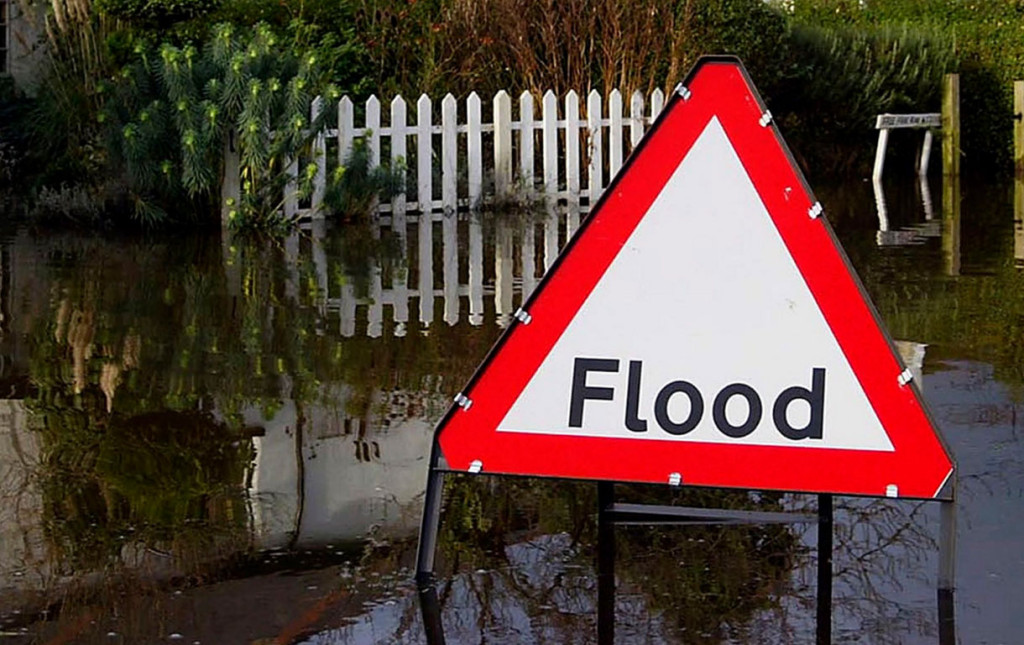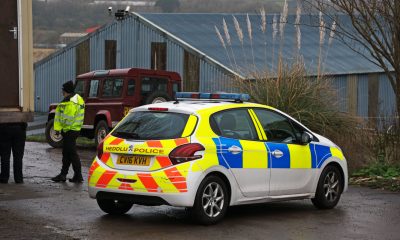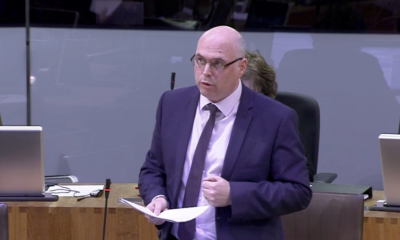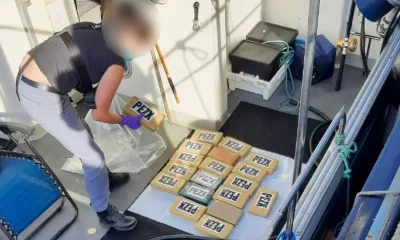Climate
Marine Delivery Routemap set to shape future of offshore wind locally

THE CROWN ESTATE has this week (Sept 11) published its Marine Delivery Routemap, outlining a comprehensive vision for the UK’s seabed, including key areas such as South Wales. The plan aims to support the growth of vital sectors like offshore wind while enhancing biodiversity and addressing the increasing demands placed on the seabed.
As the UK races towards a green energy future, this long-term strategy seeks to unlock the potential of marine resources to accelerate clean energy projects and drive economic growth in coastal regions. The focus is on balancing energy needs with environmental preservation, particularly in biodiversity restoration, a pressing issue as UK marine habitats face increasing strain.
Supporting growth in Wales
With a clear focus on supporting economic development, the Routemap aims to provide much-needed certainty to developers and investors, offering a stable framework for future seabed developments. South Wales is highlighted as a key region for offshore wind projects, especially within the Celtic Sea. The strategy seeks to foster partnerships between industries and local communities to ensure benefits flow onshore through job creation, infrastructure improvements, and investment in ports and supply chains.
In addition, The Crown Estate will work with various stakeholders, including local authorities and environmental agencies, to ensure the long-term sustainability of the marine environment. The Routemap aims to identify new areas for nature restoration and boost the region’s role in helping the UK meet its net zero goals.
A leading role in offshore wind
The UK is already a world leader in offshore wind, and The Crown Estate is building on this foundation. Its partnership with Great British Energy, announced recently, aims to bring 20-30 gigawatts (GW) of additional offshore wind power to market by 2030—enough to power almost 20 million homes. Much of this new capacity is expected to come from the Celtic Sea, benefiting South Wales and South West England.
With a mix of fixed and floating wind farm foundations under consideration, the new offshore wind projects promise to cement the region’s status as a renewable energy powerhouse, creating new skilled jobs and attracting significant investment. The report also proposes measures to de-risk these projects for developers, ensuring faster deployment of wind farms.
Balancing energy and environment
The demand for marine space is growing, particularly as the UK expands its offshore renewable energy capacity. However, this must be balanced with the protection of marine ecosystems. The Crown Estate’s Marine Delivery Routemap places a strong emphasis on biodiversity and nature recovery. This includes identifying new areas for conservation and developing strategies to restore marine habitats that have suffered due to human activity.
Ed Miliband, the UK’s Energy Secretary, praised the Routemap, saying: “The sustainability of our seabed is critical to securing the UK’s energy independence alongside protecting the environment. The ambitious plans set out by The Crown Estate will help deliver homegrown energy and create jobs while ensuring the protection of our marine environment.”
Next steps for the Marine Delivery Routemap
The Crown Estate will continue to work with partners and stakeholders to refine the Marine Delivery Routemap. A series of sector-specific updates, starting with offshore wind, are expected to follow. These will outline further developments in nature recovery, carbon capture, and other marine sectors.
South Wales and the UK’s broader marine sectors now look set to play a key role in not only delivering the energy transition but also restoring and protecting the marine environment for future generations
Climate
Flood Alert issued for Pembrokeshire Coast

NATURAL RESOURCES WALES has issued a flood alert for the Pembrokeshire coast, urging residents to be prepared for possible flooding. The alert covers the stretch of coastline between St Dogmaels, Cardigan, and Amroth, where flooding could occur.
The public is advised to take precautions and remain vigilant. For up-to-date information, residents can visit the Natural Resources Wales website or contact the Floodline service on 0345 988 1188, using the quick dial number 503013. Water levels can be checked via the ‘river, rainfall and sea data’ page on the Natural Resources Wales website.
Flood Preparedness: Do’s and Don’ts
Do:
- Follow your flood plan, if you have one.
- Ensure you know the whereabouts of your loved ones and pets, and make a plan to move them to safety if necessary.
- Safeguard your important documents, sentimental items, and valuables by placing them in a secure location.
- Keep your mobile phone charged and accessible.
- Make sure you know how to turn off your electricity, gas, and water supplies.
- Prepare a small bag with essentials such as medication, phone charger, warm clothing, and any necessary items for babies and pets.
- Move vehicles, livestock, and equipment from areas at risk of flooding.
Don’t:
- Avoid driving or walking through floodwater. Just 30cm of water can carry away a car, while 15cm is enough to knock a person off their feet.
For further updates and guidance, follow Natural Resources Wales on social media or call Floodline.
Climate
West Wales scientists to test if snow is melting high on Everest

RESEARCHERS plan to test if the snow high up on Everest is melting, threatening the water supplies of over one billion people.
Despite air temperatures being well below zero on the highest mountain on Earth, it is believed that the snow may be melting due to rising air temperatures combined with intense solar radiation.
If the theory proves correct, it would suggest that the glaciers in the Himalayas are thawing faster than expected.
Glaciers in the highest mountains of the planet are an extremely important source of water with over one billion people – including many in India, Pakistan and Bangladesh – depending on Himalayan runoff.
Changes in the rate of glacier thawing would threaten this water supply. Another danger would also be more flooding from failures of natural ice dams, or so-called Glacial Lake Outburst Floods.
The new project follows previous findings by Aberystwyth University and University of Leeds researchers which showed that the temperature of the ice in the lower parts of Khumbu Glacier, at the foot of Mount Everest, is warmer than would be expected given the local air temperature.
As part of the research, Professor Bryn Hubbard from Aberystwyth University will work with Professor Duncan Quincey of the University of Leeds to lead a team to the Western Cwm, over six kilometres above sea level and half a kilometre above base camp.
The researchers expect to go on their first trip in spring 2025 to drill into the surface of the upper reaches of Khumbu Glacier and use the boreholes to record temperatures. The team will also install automatic weather stations at the study sites.
This data will help them look for evidence of melting and refreezing within the glacier’s surface snowpack.
Professor Bryn Hubbard from Aberystwyth University’s Department of Geography and Earth Sciences said:
“It may well be a bit of a surprise to many that snow is melting within the mountain’s Western Cwm, but it is increasingly likely and it needs to be investigated and measured if we are going to be able to identify the effects of climate change on this water-stressed region and beyond.
“Understanding and recording what actually happens inside these glaciers is critical to developing computer models of their response to anticipated climate change. Equally important is developing a better understanding of how they flow so that we can better predict when dams that form on these glaciers are likely to be breached, releasing destructive volumes of water to the valleys below. This is a real risk in the Himalayas as it is in other regions such as the Andes and has the potential to endanger the lives of thousands of people.”
Scientific observations are rarely made at high altitudes because of the logistical challenges in transporting equipment.
The team is designing a new lightweight drilling setup to overcome these barriers. However, it will still face problems such as maintaining battery power in freezing temperatures and working in areas with harsh living conditions and low levels of oxygen.
Professor Duncan Quincey explained:
“Our previous work has relied on helicopters to transport our equipment onto the glacier, but given how thin the air is in the Western Cwm, we can’t be sure the helicopters will be able to fly this time. We also won’t know quite how the equipment will fare in such harsh conditions, because it is designed to operate in much warmer conditions – as could also be said for the human body! But if we can successfully drill even a single borehole within the Western Cwm, that will be a major success. Most importantly, it will lead us to being able to model how water supplies are likely to change for a large part of the world’s population with much greater certainty.”
Professor Hubbard added:
“This work will also give us a new understanding of processes and changes that are relevant for all glaciers in similar settings world-wide. Hopefully, it will resolve outstanding debates about the possibility of net mass loss at the world’s highest elevations and indicate the extent to which other glaciers within the Himalayas may also contain unexpectedly warm ice.
“We should also be able to provide insights into a rarely observed cryospheric zone that can inform public policy on climate change. As part of this, we will be providing further evidence for supporting agencies such as the United Nation’s Development Programme, and the Nepalese government. This should help them prepare for, and mitigate against, a now inevitable change in meltwater supply as climatic changes continue to influence the region.”
The project is funded by the Natural Environment Research Council and is a collaboration between academics from Aberystwyth and Leeds universities.
Climate
Wales could achieve Net Zero by 2035 under bold new proposals

WALES could reach its net zero target 15 years ahead of schedule, according to new proposals published today by the Wales Net Zero 2035 Challenge Group. The reports, which were released on Monday 16th September, aim to renew and accelerate Wales’s approach to tackling climate change, offering a strategic roadmap for reaching net zero by 2035 instead of the current 2050 target.
The proposals encompass a wide range of sectors, including education, food, energy, buildings, and transport, and outline a series of actionable strategies designed to help Wales navigate the changing climate.
Rachel Sharp, Director of Wildlife Trusts Wales, praised the potential impact of these proposals, saying: “The new proposals reveal that huge benefits to the Welsh public are possible through a faster net zero transition, including improved public health, reduced pressure on the NHS, greater energy security, a more resilient food supply, and low-carbon job generation.”
The push for an earlier target comes as Wales, alongside other nations, confronts increasingly severe and frequent weather events that have been predicted by climate scientists. With global leaders emphasising the critical point at which we stand in the fight against climate change, the need for urgent action has never been clearer. Sharp added, “It’s clear that urgent action is needed and that we should all try to reach net zero much faster.”
As a sub-nation to the UK in the upcoming COP 29 summit this November, Wales is seeking to expedite its climate action. The current net zero target is set for 2050, but over the past year, a multidisciplinary group has explored pathways to determine whether achieving net zero by 2035 is feasible.
By examining transformative changes implemented worldwide, the group concluded that with the right investment and political commitment, Wales can indeed accelerate its climate ambitions. They focused on the five key challenges of food, energy, housing, transport, work, and skills, and found a way to elevate Wales’s ambitions and drive forward the necessary actions.
Sharp further emphasised the importance of nature-based solutions in the fight against climate change, stating, “There are real opportunities for harnessing the power of nature, for example, to help Wales adapt to our changing climate. Natural habitats – when healthy and in good condition – can be enormously beneficial. Restored, re-wetted peatlands can store carbon and hold back water in times of heavy rainfall, thus alleviating flooding. Welsh citizens will increasingly need such benefits – sometimes known as ‘public goods’. Such nature-based solutions must form a bedrock of change if Wales is to achieve net zero.”
The Wales Net Zero 2035 Challenge Group’s full report can be found at netzero2035.wales.
Rachel Sharp, who serves as Director of Wildlife Trusts Wales and was an independent advisor on the group, ensured that the proposed pathways would also lead to nature-positive outcomes.
With these ambitious proposals on the table, Wales stands at the forefront of the UK’s efforts to combat climate change, potentially setting a precedent for other nations to follow in the urgent race to net zero.
-

 Health3 days ago
Health3 days agoMan dies following nine-hour wait for ambulance in Pembroke Dock
-

 Health3 days ago
Health3 days agoAmbulance error admitted in 999 call before Pembrokeshire mother’s death
-

 Crime6 days ago
Crime6 days agoMan arrested following violent Incident in Pembroke Dock
-

 Community2 days ago
Community2 days agoAffordable homes plans for fire-ravaged Cleddau Bridge Hotel site
-

 Crime1 day ago
Crime1 day agoVictim left unconscious after unprovoked attack in Haverfordwest
-

 Education6 days ago
Education6 days agoWhitland School goes into lockdown following threats to pupils
-

 Crime5 days ago
Crime5 days agoMan with limited mental capacity sees child grooming conviction overturned
-

 Crime3 days ago
Crime3 days agoDisgraced former BBC newsreader Huw Edwards faces sentencing over indecent images




























